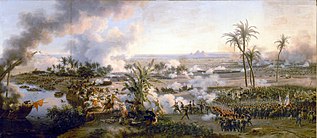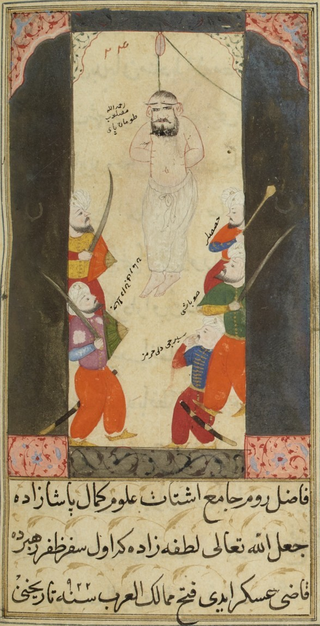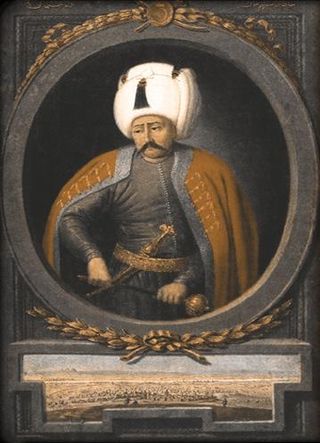
Mamluk (Arabic: مملوك, romanized: mamlūk, مماليك, mamālīk ;, also spelt Mamaluk translated as "one who is owned", meaning "slave" were non-Arab, ethnically diverse enslaved mercenaries, slave-soldiers, and freed slaves who were assigned high-ranking military and administrative duties, serving the ruling Arab and Ottoman dynasties in the Muslim world.

The Battle of Ain Jalut, also spelled Ayn Jalut, was fought between the Bahri Mamluks of Egypt and the Mongol Empire on 3 September 1260 near the spring of Ain Jalut in southeastern Galilee in the Jezreel Valley.

The Battle of the Pyramids, also known as the Battle of Embabeh, was a major engagement fought on 21 July 1798, during the French Invasion of Egypt. The battle took place near the village of Embabeh, across the Nile River from Cairo, but was named by Napoleon after the Great Pyramid of Giza visible nearly nine miles away.

Ottoman Egypt was an administrative division of the Ottoman Empire after the conquest of Mamluk Egypt by the Ottomans in 1517. The Ottomans administered Egypt as a province (eyalet) of their empire. It remained formally an Ottoman province until 1914, though in practice it became increasingly autonomous during the 19th century and was under de facto British control from 1882.

The Second Battle of Mohács, also known as the Battle of Harsány Mountain, was fought on 12 August 1687 between the forces of Ottoman Sultan Mehmed IV, commanded by the Grand Vizier Sarı Süleyman Pasha, and the forces of Leopold I, Holy Roman Emperor, commanded by Charles of Lorraine. The result was a decisive victory for the Austrians.
The battle of Konya was fought on December 21, 1832, between Egypt and the Ottoman Empire, just outside the city of Konya in modern-day Turkey. The Egyptians were led by Ibrahim Pasha, while the Ottomans were led by Reşid Mehmed Pasha. The Egyptians were victorious.

The Battle of Wadi al-Khaznadar, also known as the Third Battle of Homs, was a Mongol victory over the Mamluks in 1299.
The Battle of Ridaniya or Battle of Ridanieh was fought on January 22, 1517, in Egypt. The Ottoman forces of Selim I defeated the Mamluk forces under Al-Ashraf Tuman bay II. The Turks marched into Cairo, and the severed head of Tuman bay II, Egypt’s last Mamluk Sultan, was hung over an entrance gate in the Al Ghourieh quarter of Cairo. Or, alternatively, he was hung from the gate and buried after three days. The Ottoman grand vizier, Hadım Sinan Pasha, was killed in action.

Egypt–Mongolia relations date back to the wars between Egypt and the Mongol Empire from 1260 to 1335 AD. Official relations between the modern states were established in 1964. Cairo currently hosts Mongolia's only embassy on the African continent. The countries have signed various agreements on bilateral cooperation.

The Battle of Grocka, also known as Battle of Krotzka, was fought between the Habsburg monarchy and the Ottoman Empire on 21–22 July 1739 in Grocka, Belgrade. The Ottomans were victorious and took the city of Belgrade. The battle was part of the Austro-Turkish War of 1737–1739.

The Battle of Marj Dābiq, a decisive military engagement in Middle Eastern history, was fought on 24 August 1516, near the town of Dabiq, 44 km north of Aleppo. The battle was part of the 1516–17 war between the Ottoman Empire and the Mamluk Sultanate, which ended in an Ottoman victory and conquest of much of the Middle East and brought about the destruction of the Mamluk Sultanate. The Ottoman victory in the battle gave Selim's armies control of the entire region of Syria and opened the door to the conquest of Egypt.

The Battle of Heliopolis was an engagement that pitted the French Armée d'Orient under General Kléber against an Ottoman army, supported by British forces, at Heliopolis on 20 March 1800.

Al-Ashraf Abu Al-Nasr Tuman bay, better known as Tuman bay II was the final Mamluk Sultan of Egypt before the country's conquest by the Ottoman Empire in 1517. He ascended to the sultanic throne during the final period of Mamluk rule in Egypt, after the defeat of his predecessor, Sultan Al-Ashraf Qansuh al-Ghawri, by Ottoman Sultan Selim I at the Battle of Marj Dabiq in 1516. He was the last person to hold the title of Sultan of Egypt until the re-establishment of the sultanate 397 years later under Hussein Kamel in 1914.

The Mamluk Sultanate, also known as MamlukEgypt or the Mamluk Empire, was a state that ruled Egypt, the Levant and the Hejaz from the mid-13th to early 16th centuries. It was ruled by a military caste of mamluks headed by a sultan. The sultanate was established with the overthrow of the Ayyubid dynasty in Egypt in 1250 and was conquered by the Ottoman Empire in 1517. Mamluk history is generally divided into the Turkic or Bahri period (1250–1382) and the Circassian or Burji period (1382–1517), called after the predominant ethnicity or corps of the ruling Mamluks during these respective eras.

The SecondBattle of Ramla took place on 17 May 1102 between the Crusader Kingdom of Jerusalem and the Fatimids of Egypt.

The FirstBattle of Ramla took place on 7 September 1101 between the Crusader Kingdom of Jerusalem and the Fatimids of Egypt. The town of Ramla lay on the road from Jerusalem to Ascalon, the latter of which was the largest Fatimid fortress in Palestine. From Ascalon the Fatimid vizier, Al-Afdal Shahanshah, launched almost annual attacks into the newly founded Crusader kingdom from 1099 to 1107. It was thrice the case that the two armies met each other at Ramla.

The Ottoman–Mamluk War of 1516–1517 was the second major conflict between the Egypt-based Mamluk Sultanate and the Ottoman Empire, which led to the fall of the Mamluk Sultanate and the incorporation of the Levant, Egypt, and the Hejaz as provinces of the Ottoman Empire. The war transformed the Ottoman Empire from a realm at the margins of the Islamic world, mainly located in Anatolia and the Balkans, to a huge empire encompassing much of the traditional lands of Islam, including the cities of Mecca, Cairo, Damascus, and Aleppo. Despite this expansion, the seat of the empire's political power remained in Constantinople.

The capture of Cairo was the capture of the capital of the Mamluk Sultanate in Egypt by the Ottoman Empire in 1517.

Janbirdi al-Ghazali was the first governor of Damascus Province under the Ottoman Empire from February 1519 until his death in February 1521.

The Ottoman Empire was founded at the beginning of the 14th century. Beginning in the 16th century, it also began acquiring possessions following series of wars in coastal North Africa.

















